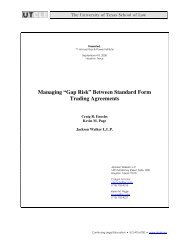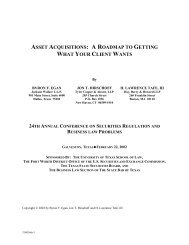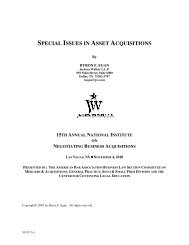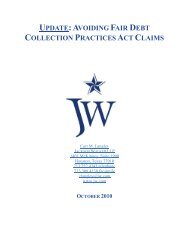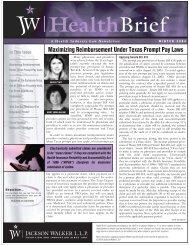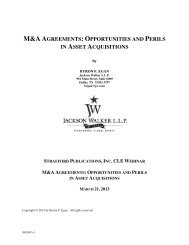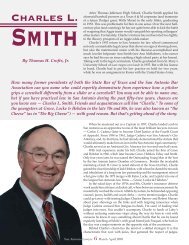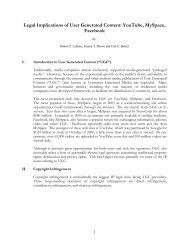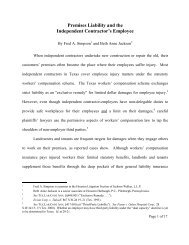Early Termination and Liquidation Provisions in Energy Trading and ...
Early Termination and Liquidation Provisions in Energy Trading and ...
Early Termination and Liquidation Provisions in Energy Trading and ...
You also want an ePaper? Increase the reach of your titles
YUMPU automatically turns print PDFs into web optimized ePapers that Google loves.
56 See In re Custom Coals Laurel, 258 B.R. 597, 607 (Bankr. W.D. Pa. 2001) cit<strong>in</strong>g In re Lang Mach<strong>in</strong>ery Corp.,1988 Bankr. LEXIS 1667 (Bankr. W.D. Pa. 1988) (“For a valid ‘triangular’ setoff to exist, Debtor must haveformally agreed to permit aggregation of debts by two creditors”); In re Hill Petroleum Co., 95 B.R. 404, 411(Bankr.W.D. La. 1988) (“The narrow exception to the rule aga<strong>in</strong>st three party, ‘triangular’ set offs, occurs whenthere is a formal agreement by the debtor that two entities may aggregate debts owed to <strong>and</strong> from the debtor [4Collier on Bankruptcy § 553.04[2] at 553-19 (1988)], Inl<strong>and</strong> Steel Co. v. Berger Steel Co., Inc., 327 F.2d 401 (7thCir. 1964)); In Re Balducci Oil Company, Inc. v. Petco Inc., Interstate, 33 B.R. 847, 853 (Bankr. D.Colo. 1983)(“However, the courts <strong>in</strong>terpret<strong>in</strong>g the term ‘mutual debts’ have carved an exception to the general rule <strong>in</strong> the‘triangular tradeoff situation.’ The courts have found mutuality between three parties, as a matter of contract law,where there was an express contractual agreement clearly ev<strong>in</strong>c<strong>in</strong>g the <strong>in</strong>tent of the parties to treat the parent <strong>and</strong>subsidiary as one entity”); In re Fasano/Harriss Pie Co., 43 B.R. 864, 870-71 (Bankr.W.D.Mich. 1984)(“The courtshave found mutuality between three parties, as a matter of contract law, where there was an express agreementclearly evidenc<strong>in</strong>g the <strong>in</strong>tent of the parties to treat the related corporations as a s<strong>in</strong>gle entity [cit<strong>in</strong>g Balducci,supra].”). A Texas court has recently held that contractual triangular setoff rights are enforceable, but only to thepro rata share of each affiliate’s portion of the aggregate liability. In re Enron Corp., No. 01-16034 (Bankr.S.D.N.Y. Dec. 2, 2001). The precedential weight of this decision is at present uncerta<strong>in</strong> as the matter is presentlyunder appeal to the 5 th Circuit Court of Appeals.57 5 Collier on Bankruptcy, § 553.03[3][b] at 553-30 (15th Ed. Rev. 2002) (citations omitted).58 It is <strong>in</strong>creas<strong>in</strong>gly common for energy market<strong>in</strong>g <strong>and</strong> trad<strong>in</strong>g companies to divide affiliated companies by product(e.g., a natural gas trad<strong>in</strong>g company <strong>and</strong> a power trad<strong>in</strong>g company), geography (e.g., a United States trad<strong>in</strong>gcompany <strong>and</strong> a Canadian trad<strong>in</strong>g company), the <strong>in</strong>tended counterparty to a transaction (e.g., a wholesale trad<strong>in</strong>gcompany <strong>and</strong> a retail trad<strong>in</strong>g company), or governmental regulation (e.g., a regulated natural gas pipel<strong>in</strong>e <strong>and</strong> anaffiliated natural gas trad<strong>in</strong>g company).59 This is due to the practice of assign<strong>in</strong>g an aggregate unsecured credit limit to a counterparty based on thecreditworth<strong>in</strong>ess of the parent guarantor. Because trad<strong>in</strong>g companies are often th<strong>in</strong>ly capitalized, they rely on ratedparents for the extension of credit from trad<strong>in</strong>g counterparties. When a credit threshold is assigned based on as<strong>in</strong>gle parent entity <strong>and</strong> is then spread among various affiliates, it is beneficial for the other party to ma<strong>in</strong>ta<strong>in</strong> rightsof setoff aga<strong>in</strong>st all of the counterparty’s affiliates both <strong>in</strong>dividually <strong>and</strong> across each other <strong>in</strong> order to manage theunsecured credit l<strong>in</strong>e as a s<strong>in</strong>gle, aggregate number. If triangular setoff is not permitted <strong>and</strong> each affiliate must beallocated credit on an <strong>in</strong>dividual basis, not permitt<strong>in</strong>g setoff across its affiliates, the amount of available credit willsignificantly decrease. E.g., Party A1 <strong>and</strong> its affiliates A2 <strong>and</strong> A3 all trade with Party B. Party B assigns anunsecured credit l<strong>in</strong>e based on the strength of the guarantor of the Party A1, A2 <strong>and</strong> A3 parties of $30 million. Iftriangular setoff is permitted, these three affiliates may be flexible <strong>in</strong> the use of this unsecured credit l<strong>in</strong>e <strong>and</strong> are notrequired to establish an <strong>in</strong>dividual limit for each affiliate so long as the aggregate limit is not exceeded. In contrast,if triangular setoff is not permitted, the aggregate unsecured credit l<strong>in</strong>e would be apportioned among the affiliates<strong>and</strong> an affiliate would not be permitted to use the unsecured credit l<strong>in</strong>e of its affiliate without the express consent ofthe other party. If triangular setoff is permitted, at any given time A1 could use $20 million of the credit l<strong>in</strong>e, A2could use $7 million <strong>and</strong> A3 could use $3 million. If the trad<strong>in</strong>g positions of the affiliates changed, the affiliatescould adjust their allocation of the credit l<strong>in</strong>e so A1 used $15 million, A2 $5 million <strong>and</strong> A3 $10 million without theconsent of Party B or any written documentation of this changed allocation. If triangular setoff is not permitted, <strong>and</strong>the affiliates were each allocated an equal share of the credit l<strong>in</strong>e, A1 could not <strong>in</strong>crease its allocation to $15 millionwithout the consent of Party B <strong>and</strong> written documentation adjust<strong>in</strong>g the credit l<strong>in</strong>e, even if Part A3 only used $5million of the $10 million credit l<strong>in</strong>e it was allocated.60 11 U.S.C. § 362(b)(6).61 11 U.S.C. § 362(b)(17).62 11 U.S.C. § 101 et seq., here<strong>in</strong> “Bankruptcy Code”.63 11 U.S.C. §362(a).64 11 U.S.C. §362(a).65 “[The automatic stay] has two broad purposes. First, it provides debtors with protection from hungry creditors:‘It gives the debtor a breath<strong>in</strong>g spell from its creditors. It stops all collection efforts, all harassment, <strong>and</strong> allforeclosure actions. It permits the debtor to attempt a repayment or reorganization plan, or simply to be relieved ofthe f<strong>in</strong>ancial pressures that drove him <strong>in</strong>to bankruptcy.’ H.R. Rep. No. 595, 95 th Cong., 1 st Sess., at 340 (1977),repr<strong>in</strong>ted <strong>in</strong> 1978 U.S.C.C.A.N. 5963, 6296-7. Second, the stay assures creditors that the debtor’s other creditorsare not rac<strong>in</strong>g to various courthouses to purchase <strong>in</strong>dependent remedies to dra<strong>in</strong> the debtor’s assets: ‘The automaticstay also provides creditor protection. Without it, certa<strong>in</strong> creditors would be able to pursue their own remediesaga<strong>in</strong>st the debtor’s property. Those who acted first would obta<strong>in</strong> payment of the claims <strong>in</strong> preference to <strong>and</strong> to the17




